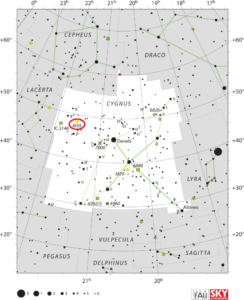Messier 39 (M39) is a large open cluster located in the constellation Cygnus, the Swan. The cluster’s apparent size is 32 arc minutes, making it larger than the full Moon, which means that M39 is best observed in binoculars and small telescopes at the lowest magnifications. Messier 39 is one of the nearest Messier objects to Earth.
| Description | |
| Visible From Pacific Northwest | May To November |
| Best Time To Observe | June, July, and August |
| Minimum Size Of Viewing Device | 7×50 binoculars |
| Object Type | Open Cluster |
| Designations | Messier 39, M39, NGC 7092, Collinder 438, C 2130+482, OCl 211.0, MWSC 3521 |
| Right Ascension | 21h 31m 42s |
| Declination | +48°25′ |
| Constellation | Cygnus |
| Absolute magnitude | +5.5 |
| Apparent magnitude | -2.5 |
| Apparent dimensions | 32′ |
| Object Radius | 3.6 light years |
| Distance From Earth | 36 |
History
The cluster may have been discovered by the French astronomer Guillaume Le Gentil in 1750, and possibly even by the Greek philosopher and scientist Aristotle as a comet-like object around 325 BC.
Charles Messier catalogued the cluster on October 24, 1764.
English astronomer John Herschel catalogued the cluster as h 2126 in September 1829 and later added it to the General Catalogue as GC 4681. Herschel described M39 as a “cluster; very large; very poor; very little compressed; stars between 7th and 10th magnitude.”
Locating M39 In The Sky
Messier 39 can be located by star-hopping from Deneb to 4th magnitude star Rho Cygni, which lies some 9 degrees to the east. The cluster lies 3 degrees north of the star.
Deneb is very easy to find in the night sky as it belongs to two prominent asterisms: the Northern Cross and the Summer Triangle. It is the star marks the tail of the celestial Swan and the faintest corner of the Summer Triangle, a familiar summer asterism formed by Deneb and the bright stars Altair in Aquila constellation and Vega in Lyra. The best time of year to observe M39 is in the summer months, when Cygnus is high overhead.

Viewing M39
The cluster can be resolved in 7×50 binoculars, which reveal its triangular shape, with three bright stars marking the corners. M39 is best observed in binoculars and small telescopes at the lowest magnifications.
Photographing M39
Being a large open cluster, M39 will require some similar skills used for imaging other open cluster objects, such as the autoguiding. The autoguiding will need to spot on for the image to be perfectly clear. One can utilize a DSLR to take the image, but make sure to utilize a telescope. 1 hour or so of imaging will be enough to gather enough detail of Messier 39 to obtain a wonderful image.
https://www.galactic-hunter.com/post/m39-open-cluster-in-cygnus
Sources And Further Reading
Descriptions of all of Messier Objects can be found here.
https://freestarcharts.com/messier-39

Be the first to comment on "Messier 39"